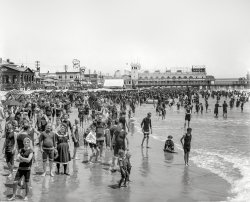
MAY CONTAIN NUTS

Search Shorpy
SHORPY ART

Framed or unframed, desk size to sofa size, printed by us in Arizona and Alabama since 2007. Explore now.
Join and Share
Ad-Free Shorpy
Shorpy is funded by you. Patreon contributors get an ad-free experience.
Learn more.

Recent comments
- I wondered the same thing.
- The location in 2009
- Pill Pusher
- Roll your own
- Rugged and real!
- Civil War history
- Early EV?
- A Charles Purcell - Mama Cass Connection
- Uncle SAAM
- Obfuscation
- One Chocolate Soldier rode away
- Victor Marquis de la Roche
- The Little House Across Way ...
- Vanderbilt Gates
- Vanderbilt Mansion
- You can still see that gate
- Withering heights for me
- So Jim,
- Top Heavy
- Re: Can't Place It.
- Bus ID
- Since you mention it
- The White Pages ?
- Moonlight Tower
- 1907?
- Fire(men) and Water
- Can't Place It
- Can anyone
- Wings
- Where's Claudette and Clark?
Member Photos
The Shorpy
Printporium
Printporium
Search Shorpy
Search results -- 30 results per page
- Cross-Country: 1915
- ... Still, it makes my trip harrowing to 1000/1500 IBA ride to Colorado, Pikes Peak and points west last summer pale in comparison.
Right ... Posted by Dave - 04/06/2013 - 11:50am -
![Cross-Country: 1915 1915. "Baker and O'Brien, transcontinental motorcyclists, back of White House." Bud Baker and Dick O'Brien, whom we first met here. In May 1915 they embarked on a five-month, 10,000-mile jaunt to the West Coast via Indian motorcycle to see the California expositions. Harris & Ewing. View full size.
Hard to believe this actually happened....10 K miles, 5 months--1 K a week? Seems hard to believe--no headlight so no night riding; tires no good for the muddy roads they'd meet with after every thunderstorm; the stone exhaustion riding that unmuffled, suicide-clutched, barely-sprung boneshaker; the flat tires, the dust, the breakdowns.... Where are their goggles (they wouldn't get far without eye protection.) Where are their gloves? Where's their repair kit--that box on the gas tank won't begin to hold their spares? Where's their tent, gear, clothing, canteens? Apart from the breeches and puttees or gaiters and that snappy Indian pennant, they seem woefully unprepared.
[Not to belabor the obvious, but: This not during their trip. They lived in Washington. - Dave]
Cool Boys of the RoadAdmire these guys immensely. What an adventure. With a great masculine style. I'm fascinated by those shin guards. Modern armor for the modern man, very chic.
Handsome DevilThat one on the left is dreamy. I wonder if he's got a great-grandson...
Leather putteesThe "shin guards" appear to be standard-issue Army leather puttees, as used by the cavalry starting in 1911:
http://onlinemilitaria.net/shopexd.asp?id=3138
ArithmeticNot to further belabor, but 10,000 miles over five months works out to about 475 miles a week, or less than 70 miles a day.
Raindrops keep falling on my shin guardsIt's so late '60s, early '70s. This would have made a great property for Paul Newman and Robert Redford back in the day.
70 miles....70 miles a day on dusty, muddy, ungraded country roads or greasy city cobblestones. 70 miles a day on tires regularly puncturing. 70 miles a day over mountain passes with thin oxygen (check that carburetor!) and nighttime temps below freezing. 70 miles a day in Plains thunderstorms, desert dust (check that carburetor again, boys!), across skittery rail and trolley tracks, through piles of slithery horse poop. 70 miles a day without decent roadmaps. It would have been a grand odyssey, but I’d dearly love to know what actually happened.
If they were simply swanning around DC on their cherry Indian looking intrepid and not yet actually prepping to leave, fine, but I wish there were a later picture of them suited, geared, gauntleted, goggles, and ready to roll. I wouldn’t ride around the block dressed this way, sexy puttees or no.
Indian PowerplusDecember 1915 ad from a Kingston, Jamaica, newspaper that mentions the boys' trip.
Where's their book!?Dear Lord - what an adventure -- where's their book? I hope these two guys lived to enjoy enormous notoriety and maybe a few $$
Did they really make the trip? The suspense is killing this 76 y-o scooterist!
Amazing adventureIt was a different time. I saw a documentary about Indian cycles. One of the selling points of the early models including this one was its ability to go through muddy, nasty, rough road conditions where cars would be stuck. If it got to bad you could get out and push/pull the bike where a car needed a team of horses to get it out. Still, it makes my trip harrowing to 1000/1500 IBA ride to Colorado, Pikes Peak and points west last summer pale in comparison.
Right Write a book? Probably not though they more than likely wrote letters to their loved ones all along the route. It was a different time. Mail traveled by rail. Phones were in 30% of the homes. Tennessee wasn't electrified and these guys road rode two-up on a motorcycle across the same place where barely more than 50 years earlier the Poney Pony Express riders road rode.
I guess we all have hero's heroes. There's two more for my list.
William Crane
(The Gallery, D.C., Harris + Ewing, Motorcycles)](https://www.shorpy.com/files/images/05779a.thumbnail.jpg)
- Careful, Kitten: 1916
- ...
The first US battleship to mount 16 inch guns was the Colorado class BB, the Maryland, laid down in 1917 and commissioned in 1921. ... Posted by Dave - 10/11/2008 - 2:06pm -
![Careful, Kitten: 1916 1916. "Indian Head, Maryland. Navy proving ground. Residence of George Swann, damaged by 16-inch shell that hit another in sandbank, and was deflected over country at 3/4 angle. The shell, where it stopped in dooryard." Harris & Ewing Collection glass negative, Library of Congress. View full size.
Gee, Mr. Swann, Sorry About ThatPresumably it had been determined by the time the photo was taken that the shell was harmless...still, if I'm Geo. Swann, I'm getting my daughter and kitten off the porch ASAP, and calling the Navy to make sure they come and get the thing. I wonder what was in those buckets on the table?
Questions, questions...How long was the shell sitting there? Was it a dummy round used for testing? How long did it take them to make some makeshift repairs, like moving the porch railing over, and removing much of the debris? What's up with the "scaffolding" on the side of the house? Where did the shell land, and which way did it come from? Is that where it ended up after it landed, or did someone move it there? Is that a piece of window on the porch roof? Is the kid watching ants?
16 inch?I certainly am not a naval historian by any means but the caption having 16 inch shell and 1916 made me do a quick internet search on US naval gun sizes and when these took place.
The first US battleship to mount 16 inch guns was the Colorado class BB, the Maryland, laid down in 1917 and commissioned in 1921. Previous classes (and there were many in the 1905-1917 timeframe) went from 12 inch to 14 inch.
Of course, 12, 14 or most likely incorrectly stated as 16 inch will not help the porch or Mr. Swann's condition!
[The shell was not fired from a battleship, and 16 inches seems to be correct. See below. Before a new gun is mounted on a ship, it has to be tested, which is what the Indian Head Proving Ground was for. - Dave]
Worthy of another look.This incident has not just occurred. Temporary posts (sapling trunks, by the look of it!) have been erected to hold up the porch roof. Therefore I conclude that the round is a dummy, thus the lack of urgency in removing it and the fact that child and kitten are allowed in such close proximity.
Elementary, my dear Watson.
The gov'mentI wonder if the Navy paid for repairs.
DahlgrenThis kind of testing was moved to Dahlgren, VA in the 20s
These Things Happen...As we used to say in artillery:
"Shot OVER."
"Shot OUT!"
Green AcresI half expected to see Lisa and Oliver Douglas standing on the porch as Mr. Haney drives up to sell them a new one.
What a different world it was in 1916.Love Government's response: Give us a bigger proving ground or just get used to stray naval shells flying every which way.
Indian HeadAs a native of Indian Head, the Naval Ordnance Station is still an integral part of life in Southern Maryland, about 25 miles from Washington, DC and sitting just across the river from Quantico. Many of our families' livelihoods depended upon the important defense work being done at the "Naval Propellant Plant," as it was called when I was growing up. Because of its location on the Potomac, a lot of testing was done in the water. Several times when I was a kid, some horrible accident would occur when explosive dust, accumulated over time or through carelessness, exploded. I remember our house shaking as if an earthquake had hit and then hearing the sirens on the base, knowing that there had been an explosion and praying my father had not been in it. He was a sheet and plate metal worker and retired from the base after 30 years of service and became a vocational education teacher in the Charles County school system. He lived to be 81 and he and my mother were two of the oldest residents when the town of Indian Head celebrated its 100th anniversary in 1990.
(The Gallery, Boats & Bridges, Harris + Ewing)](https://www.shorpy.com/files/images/02111a.thumbnail.jpg)
- Georgetown: 1939
- October 1939. "Georgetown, Colorado -- an old mining town in the mountains." Medium format acetate ... Georgetown Georgetown is one of my favorite spots in Colorado. This shot would have been taken in what is now the parking lot next ... Posted by Dave - 08/14/2020 - 1:17pm -
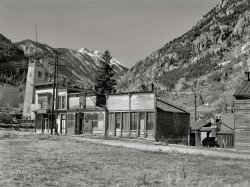
- Yesterday's Headlines: 1941
- ... of Mr. Williams' rig.
Hot Leadville In Saguache, Colorado, there's a newspaper called the Saguache Crescent that is still ... Posted by Dave - 12/12/2018 - 9:30am -
![Yesterday's Headlines: 1941 June 1941. "Mr. Cary Williams, editor of the Greensboro Herald Journal, a newspaper in Greensboro, Georgia." Spitting hot lead at an ancient Linotype machine. Note the custom-fitted ergonomic back support and whittled-down chair. Medium format negative by Jack Delano. View full size.
Amazing technologyIn the late 1970s I was studying graphic design, and our instructor took a group of us to the offices of Sunset Magazine to see a linotype in action. The publication was just weeks away from going computerized, but the operator put on quite a show for us. There's nothing like moving parts to make work seem entertaining.
etaoin shrdluI still have-and use regularly-a Linotype machine. Also, the metal is melted and used at around 535 to 545 degrees. Less than that it won't melt properly, and much above that is when you are apt to get squirts.
The aroma is uniqueI worked in the office of a hot lead Hearst paper in Baltimore in the '70s. The building’s back stairs included a landing that was open to the pressroom, and the odor of molten lead poured into stairwell. Nothing else smells quite like that. Shorpy brought it all back to me!
Printer's DevilThis reminds me of one of my favorite Twilight Zone episodes starring Burgess Meredith as the devil masquerading as a reporter who promises to salvage a failing newspaper in exchange for the editor's soul.
LineageI believe Etaoin Shrdlu was Lorem Ipsum's grandpa.
ETAOIN SHRDLUA well-known "phrase", but I followed Dave's LMGTFY link, and was surprised not to find the reference that first came to mind -- "Etaoin Shrdlu" is the title of a 1942 short story by Fredric Brown about a sentient Linotype machine.
Etaoin shrdluIt had to be said.
Huh?Over my head this morning.
[Google it. - Dave]
ProgressEarlier this week, I ran across a story of an 8 monitor, 18 million pixel custom workstation with a sling chair that is like a modern incarnation of Mr. Williams' rig.
Hot LeadvilleIn Saguache, Colorado, there's a newspaper called the Saguache Crescent that is still produced daily on an old linotype machine.
Ah, yesterdayIn the 1960s when the Comanche (Texas) Chief was still a hot-type operation, I used to hang out in their print shop, watching Bob Carpenter set type (he was good enough as a reporter AND printman that he would sometimes compose his articles directly on the lino) and Minor Taber and Woody Ormsby run the jobbing presses.
If I hit at the right time on Thursday afternoon, I could watch the crew wind up the big rotary press to run the week's edition of the Chief; that was a special treat.
A Blast from the PastWhen I was a high school senior in Chicago I took a print shop class, where we were taught to operate a Linotype machine just like this one. It always scared the hell out of me; we were warned that if we mistakenly left an open space in one of the lines of brass keys we were assembling, molten lead at 700 degrees Fahrenheit would "squirt" in our faces. Our machines were old and cranky, and I could rarely type out more than three lines before something would jam. Now I see them on display as museum pieces ... yikes!
Spitting LinotypeI have a documentary on the Linotype. (www.linotypefilm.com) Apparently, experienced operators could hear a warning sound to back off quickly to avoid getting hit by a bit of hot lead. I got a chance in the 1960s to see a room full of them at the News Call Bulletin in San Francisco. You don't forget a mechanical wonder like that.
Family TraditionCarey Jones Williams, April 6, 1901 - July 9, 1991
Carey (with an "e") later served on the University of Georgia Board of Regents. His son Carey Jr. is the current editor (and owner) of the Greensboro Herald Journal.
Not dead yetThere's a movie: http://www.linotypefilm.com and the Linotype is so loved that there are at least two organizations in my immediate area (Waltham and Haverhill, Mass.) with one or two working units:
https://www.charlesrivermuseum.org/
https://museumofprinting.org/collection/
I love old, well built, intricate and obsolete machinery. And Real Computers have switches and blinking lights.
LinosaursBoth The Printing Museum in Houston and the Baltimore Museum of Industry have full print shops on display, and if you hit 'em on the right days a retired operator (from The Houston Chronicle or Baltimore Sun) will be there to make them sit up and talk for you.
(Technology, The Gallery, Jack Delano, The Office)](https://www.shorpy.com/files/images/SHORPY-8c05858a.thumbnail.jpg)
- Telluride Tracks: 1940
- ... gauge railway yards, train and water tank at Telluride, Colorado." Medium format negative by Russell Lee for the Farm Security ... was used in her later years as a switcher in the Durango, Colorado yard, finally meeting the scrapper’s torch in 1954.
The last ... Posted by Dave - 06/22/2019 - 9:34am -
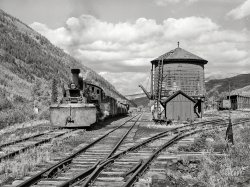
- "Old 71": 1941
- September 1941. Central City, Colorado. "The 'Old 71' engine of the Colorado and Southern Railway, which carried ore and passenger cars from Denver ... Posted by Dave - 11/17/2019 - 5:02pm -
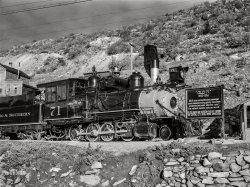
- On the Road: 1942
- ... 1942. "Highway view along U.S. 40 in Mount Vernon Canyon, Colorado. Looking east toward Green Mountain, with Shingle Creek below." ... Posted by Dave - 06/26/2017 - 3:36pm -
![On the Road: 1942 December 1942. "Highway view along U.S. 40 in Mount Vernon Canyon, Colorado. Looking east toward Green Mountain, with Shingle Creek below." Kodachrome transparency by Andreas Feininger, Office of War Information. View full size.
Can that bea 1941 Lincoln? I've heard about them but don't remember seeing many photos of them.
[The car is a Buick. - Dave]
The Jade JalopyWhat a beautiful shade of green. I'll take anything in it, thanks.
Gorgeous ShotCan anyone read that yellow sign? I think the top word is "Wrong".
["Winding Road" -tterrace]
(The Gallery, Kodachromes, Andreas Feininger, Cars, Trucks, Buses)](https://www.shorpy.com/files/images/SHORPY-1a34858u2.thumbnail.jpg)
- Crossroads: 1939
- ... PA.
The scene above reminds me of the 'highlands' of Colorado just outside of Pubelo.
Rural Routes going away It is becoming ... Posted by Dave - 07/24/2012 - 7:06pm -
![Crossroads: 1939 October 1939. "Crossroads off the highway in a cut-over area. Boundary County, Idaho." View full size. Medium-format nitrate negative by Dorothea Lange.
Box numbersInteresting that the mailboxes have box numbers rather than addresses. I guess they're the equivalent of post office boxes, except they're not in a post office.
[Rural delivery addresses were usually box numbers combined with a route number. The farm I grew up on in Florida in the 1970s was Route 1, Box 66. - Dave]
Rural RoutesMy parents still have a Rural Route x, Box y address just outside of Birmingham, Alabama. Apparently the Post Office is doing away with it, though.
RR & BoxWe had a Rural Route prior to purchasing our new house. Still don't have home delivery and have to drive to the Post Office to retrieve our mail here in PA.
The scene above reminds me of the 'highlands' of Colorado just outside of Pubelo.
Rural Routes going awayIt is becoming more and more unusual to see Rural Route addresses in most places; when 911 became more common all addresses had to be changed to something physical. Typically the Post Office and some sort of regional planning council made the address changes.
[Our "Route 1, Box 66" got changed to "4397 154th Terrace." Bleh. - Dave]
Rural RoutesStill have rural delivery here in Missouri. But the weekend vandals enjoy bashing our mailboxes so it may not last much longer.
KFOGDave - You're the morning guy on KFOG, right? I think so....
[Um, no. - Dave]
CountiesI live in Kootenai, about thirty minutes away from Boundary. It's so very interesting to see a local picture, especially one taken by the talented Dorothea Lange! Thank you very much for posting it!
(The Gallery, Dorothea Lange, Rural America)](https://www.shorpy.com/files/images/8b35434u.thumbnail.jpg)
- Payne and Twomey: 1925
- ... the wording on the lower banner. Its offices were in the Colorado Building in downtown Washington. I'm still trying to figure out where ... Posted by Dave - 09/03/2012 - 3:33pm -
![Payne and Twomey: 1925 Washington, D.C. "Texas Company. Payne & Twomey, 1925." View full size. National Photo Company Collection glass negative. Who wants tobacco cakes?
Chero-ColaPayne & Twomey's is apparently a proud purveyor of Chero-Cola. I looked it up and it was one of several soft drinks under the umbrella of Chero-Cola Co. which was later renamed the Nehi Corporation. Chero-Cola was revamped in the mid-30s and rebranded as Royal Crown.
[Below, a 1922 Chero-Cola ad from an Ohio newspaper. - Dave]
Hydraulic Press BrickBased on a bit of reading between the lines, I believe the industrial building in the background is the Hydraulic-Press Brick Company. In the 1920s it specialized in a face brick called Hy-tex, which could be the wording on the lower banner. Its offices were in the Colorado Building in downtown Washington. I'm still trying to figure out where the plant was.
[Washpost archives: In 1932 the Hytex brick plant was on the Alexandria Pike. - Dave]
Utility polesHow crude those posts look. They appear to be as is tree trunks. I wonder if the were coated with something like creosote. How did they stand up over the years?
Shorpy, You've Done it AgainAnother fantastic photo. I notice the poles all look like raw trees pressed into quick service. I love the humble gas station building; it reminds me of ones you might have seen in the south, yet here it is in D.C. The industrial tanks and buildings that curve along the road on our left make for even more interest. This tiny store and gas station is the "grandfather" of today's convenience store.
P&TI just wanna try the Tobacco Cakes. Sounds yummy.
Intriguing!Okay, kids, let's get our Sherlock Holmes hats on. Bare trees indicate not Summer months; not many leaves around, probably end of Winter into Spring; tilth of soil supports late Spring; light source would be biased to the South, so we're probably looking in a southerly direction; smoke blowing stiffly to left, a strong breeze usually from the North West in this area; and to the right, the embankment seems to be for a railroad. Hmmmm. If in D.C., this would be North East, and I'd have to guess betwixt Rhode Island and New York Avenues. Any guesses? This is an incredible photograph. Thanks!
(The Gallery, D.C., Gas Stations, Natl Photo)](https://www.shorpy.com/files/images/27315u.thumbnail.jpg)
- Gold Coin Mine: 1900
- Circa 1900. "Victor, Colorado. Gold Coin Mine." 8x10 inch dry plate glass negative, Detroit ... Posted by Dave - 07/20/2012 - 1:38pm -
![Gold Coin Mine: 1900 Circa 1900. "Victor, Colorado. Gold Coin Mine." 8x10 inch dry plate glass negative, Detroit Publishing Company. View full size.
Coontown 400Just to the right of the building with the painted advertisement for "Elector" cigars, you can see a fence plastered with advertising for "Coontown 400", a variety troupe.
Whether it is the same troupe as below or not, I'm not sure. Perhaps they had already made bookings and then went bust. I couldn't find another revue by the same name. Although there is a cartoon book called "Coontown's 400" by E.W. Kemble, published in 1899, "with what we would today consider racist portrayals of "darkies".
"Coontown Four Hundred (also Coontown 400). Variety troupe, active at the turn of the century, which underwent a number of changes of name and management. The orig. troupe, under white proprietorship, played Cincinnati, OH, in May 1899 with a roster that included the Blackstone Quartet, Tom Brown, Edna Alexander, Ida Forsyne, Whitney and Tutt, and others; it then disbanded in Nov. of the same year for non-payment of salaries. Management was taken over by Howard McCarver in September 1901, and the name was changed to A Honolulu Coon Co..." "The African American theatre directory, 1816-1960"
"One of Arthur Marshall's anecdotes has Marshall and [Scott] Hayden both living with the Joplins. This had to have been in late 1902 or 1903, for Marshall had been on a two-year tour with the Dan McCabe's Coontown 400 until the fall of 1902. It was probably at the end of the tour that he moved in with the Joplins, for Dan McCane in December was in St. Louis and visited the Joplins" "King of Ragtime: Scott Joplin and his era"
One Hundred and thirteen polesAmazing. Telephone, telegraph, electric, I counted one hundred and three poles before I started seeing double. Then spotted several more. You could spend days studying the histories of technology, architecture, construction, transportation, manufacturing, marketing and more, just in this single photograph. I love it. Still haven't found Waldo, however.
What a Project!Super photo from which to fashion a scratch built model railroading site in one's basement. So much going on, track at several different levels, limitless building designs, and a background that leads into a diorama-like mountain scenic.
I'd put a flag on that pole next to the smokestack, however.
Victor RR Depot - then and nowFrom the building with the Elector Cigars sign, follow that street to the right and where it ends you will find the Victor Midland RR Depot. The depot's overhanging roof casts dark shadows on the side of the building, which was the center of much activity at the time this photo was taken. The depot still stands today in relative isolation and four photos of it taken in 2006 can be viewed on this page. The eastern end of the depot is closest to the camera in the 1900 photo, which looks to the southwest.
August 1899 FireA large part of Victor burned to the ground in 1899, and it is said that most of the town was rebuilt in six months of brick instead of wood. It does seem as though there is a lot of "new construction" around!
(The Gallery, Mining, Railroads, W.H. Jackson)](https://www.shorpy.com/files/images/4a09194a.thumbnail.jpg)
- Battle Fleet Champions
- ... relatively short barrels and an open foredeck while the Colorado class Battleships had a much longer barrel as it was standardized ... last A turret when mounted in a B turret. Addtionally, Colorado's didn't have the open foredeck, they had a gunwale that would have ... Posted by thomas - 02/09/2011 - 8:45am -
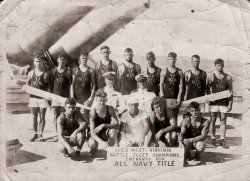
- Municipal Light: 1940
- ... September 1940. "Derelict lighting plant in Silverton, Colorado." Medium format negative by Russell Lee for the Farm Security ... City, Volume 7, July-December 1912
Silverton, Colorado, a thriving town of nearly 3,000 people, at an altitude of over 9,000 ... Posted by Dave - 09/01/2018 - 6:07pm -
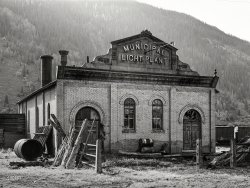
- Golden Boys: 1942
- October 1942. State School of Mines in Golden, Colorado. "Speed in metallurgical analysis, to match the rapidity with ... "The Age of the Golden Wireless."
Great school! The Colorado School of Mines in Golden is one of the best engineering schools in ... Posted by Dave - 05/30/2014 - 7:52am -
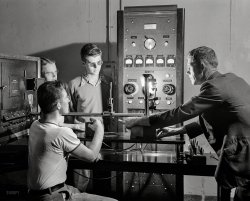
- High Court: 1940
- ... September 1940. "San Juan County Courthouse. Silverton, Colorado." Medium format acetate negative by Russell Lee for the Farm Security ... county and has the smallest population of any in Colorado and this structure must really stand out there. There's some colour ... Posted by Dave - 04/30/2020 - 2:08pm -
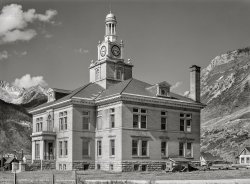
- Crossing Guard: 1943
- ... (vicinity). Military sentry stationed at a bridge over the Colorado River along the Santa Fe Railroad between Seligman, Arizona, and ... Posted by Dave - 06/12/2014 - 5:05pm -
![Crossing Guard: 1943 March 1943. "Topock, Arizona (vicinity). Military sentry stationed at a bridge over the Colorado River along the Santa Fe Railroad between Seligman, Arizona, and Needles, California." Photo by Jack Delano. View full size.
How in the worldcan you tell this is a shotgun? What software are you using to blow up this picture?
[Distinctive profile. -tterrace]
He Means BusinessSomething you don't often see in pictures. The guard is armed with a pump shotgun, probably either a Model 1897 or a Model 12. Most often you'll see soldiers on guard duty armed with an M1 or occasionally with M1903. There may have been other guards here armed with rifles to deter saboteurs at a distance, but this guy is ready for close-in defense.
Sentry duty shotgunI think the guard is armed with a pump action shotgun. I've read that shotguns were often used on various guard and protection details during the war.
Red Rock BridgeThis is Santa Fe's Red Rock Bridge, completed in 1890, and due to be replaced with a new bridge just two years after this photo was made. This then became the US 66 bridge for another 20 years. More here.
Hot DutyThe last time I was in Needles, the temerature was 119 degrees. I felt like I was going to die walking between my air conditioned car and the air conditioned gas station. This is not the place where you want to be standing outside in battle fatigues and a steel helmet. This poor soldier may have screwed up somewhere else in order to draw this grueling duty.
6 Rails Across the BridgeWhy 6 rails across the bridge?
Gantlet track.
There is double track on each side of the bridge, which was built when a single track was sufficient for the traffic on the line. Traffic increased to where it became necessary to double track the line, but as a cost savings the bridge, only wide enough for a single track, was retained. Rather than put switches at each end of the single track segment, the bridge was laid with gantlet track. The two rails of each of the tracks for each direction were merged together about 6" apart.
Counting from the left, the first and fifth rails are for trains in the approaching direction. The second and sixth for trains moving away from the photographer (as in, the caboose seen beyond the bridge.) The two center rails are guard rails, as a safety measure common on all bridges in case of derailment.
My Two PelletsCall me a scatterhead, but that barrel looks too thin to be a scattergun barrel. In other words, it's hard to gauge but it seems too thin to be a shotgun barrel. AFAIK sentry duty shotguns in WWII were 12 gauge. That barrel looks no bigger than a .410, if that.
I think I figured it outIt's a .30 cal. Springfield shotgun.
Light And DistanceI'm no expert in photography, but I'd say the reason the barrel looks so thin is because of the effect of light, background and distance on a cylindrical surface. I've seen this before on items much closer. By the way, the barrel has been shortened to 18 to 20 inches, just right for up close shooting. I don't know if this was factory done or done by an armorer in the field. After looking at it more, I'm also not sure it's a Model 12 or a '97. The forearm looks a little fat for those. Could be a Mossberg.
[Here's a closeup. -tterrace]
Three pumpsI can't find a record of any Mossberg shotgun being used by the US military in WW II, so the choices are:
Winchester M1897, Winchester M12, Remington M31
The picture (on screen, at least) is too bad to tell for certain. If I had to guess I'd say it was the 1897. If it's possible to see the receiver and grip on a high quality print, one can tell for certain. The M1897 has an exposed hammer and a flatter, longer grip section than the M12 between the receiver and the top of the stock. The M12 and M31 are easy to tell apart.
The Browning Auto 5 was also used, but the weapon in the picture is definitely not one of those.
(The Gallery, Boats & Bridges, Jack Delano, Railroads)](https://www.shorpy.com/files/images/SHORPY-8d27444a.thumbnail.jpg)
- Fill In the Blanks: 1931
- ... her involvement with the Order of the Eastern Star (in Colorado, apparently), as hinted by her ring.
A search on Ancestry.com ... Posted by Dave - 04/20/2013 - 9:03pm -
![Fill In the Blanks: 1931 UPDATE: The photo now has a caption.
Signs the president's name. Mrs. Leafie E. Dietz, recently appointed the "Secretary to Sign Land Patents," a position in the Government Land Office which, since its creation under President Arthur, has been held only by women. She signs "Herbert Hoover" to land patents and is the only person who has authority to sign the President's name.
Washington circa 1930. The document at hand in this unlabeled Harris & Ewing negative is a form ready for the signature of Herbert Hoover. Perhaps someone versed in bureaucratic history will recognize this lady. View full size.
CylindersCould they be for sending messages through a pneumatic tubing system?
The Mysterious CylindersThe Land Office probably trafficked in large documents -- maps and such. The cylinders might have to do with storing, transmitting or duplicating them. They look too long to be dictation cylinders or radio batteries.
Difficult JobCan you imagine how difficult it must have been for a woman in those days to be part of the White House staff? I love her glasses and her very direct, no nonsense look. There is a small star on her ring. I imagine someone will recognize its significance.
I bet those flowers wiltedThe moment she sat next to them.
Possible identificationI'm not sure, but I think that might be Ed Wynn.
A woman before her time?It looks like she was married and had a successful career, too!
Not an Ordinary Worker BeeWell dressed, with a fat engagement/wedding ring combo and what looks like an Order of the Eastern Star ring.
Job DescriptionThe document is a form of the General Land Office, predecessor to the Bureau of Land Management; the lady is authorized to sign the President's name as described in a caption accompanying a 1937 Harris & Ewing photo of another lady in what may be the same room:
Signs president's name. Washington, D.C., Sept. 8. Affixing the signature "Franklin D. Roosevelt" to land grants and patents, Jeanne [...], 20, is getting a great thrill out of her new [...]h the General Land Office. As "Secretary to the President [...]ning Land Grants and Patents," she is the only [...] authorized to sign the president's signature to documents. She is the youngest person ever appointed to the position. 9/8/37
Cylinders????What are the tall cylindrical objects against the wall? If we could identify them it might give us a clue as to what department she works in. The labels on them are far too out of focus to read.
Soil samplesSince this is a land management office, the tubes might well be soil sample cores. Contemporary tubes are a similar size and shape.
[The Land Office didn't have anything to do with dirt. - Dave]
Pot MarigoldThe flowers appear to be the common calendula officianalis, or the more common name of pot marigold. A popular cut flower back in the day, it has the unusual characteristic of sleeping, or folding up at night time. Much used in present day lotions and fragrances.
Re: Cylinders?My first thought, as well, but aren't they awfully long canisters? The required bend radius in the pneumatic lines would be huge!
Her name is Leafie E. DietzAfter a fun little search these past couple of hours, I've discovered her identity. It is Leafie E. Dietz, designated by President Hoover in 1931 to sign land patents, by Executive Order 5529.
This photograph shows the preparation of a land patent granted to Janie Furr, for 640 acres of land in two sections (8 and 17) in Grant County, New Mexico, dated Jan. 21, 1931.
The most exciting part was the hunt! I work in land administration, so I immediately recognized the document as a patent or similar document.
I rotated the image and messed with the contrast to try and read the document. I immediately recognized a chunk of the writing as a legal description. At first, I couldn't make out much, but after recognizing the words "New Mexico Meridian" (23rd Meridian) and "six hundred forty acres", I was able to discern the township and range: T16S R15W (or "Township sixteen south of Range fifteen west" as it is written on the patent). From there, I did a simple search of the BLM's land documents using the legal description, which pulled the original patent (fully filled out by that point!) image with matching description! (attached below, original accession # 1043289).
Stupidly, I did not look down at the signature block, and attempted to locate the identity of this woman through a search of the congressional registry for 1931. After searching the GLO's employees, as well as the executive office's employees (thanks to the hint from Dave's comment), I was not able to find anything further...until...
I took another look at the patent, and voila! How blind could I be?! There, under "Herbert Hoover"'s signature, is the notation "By Leafie E. Dietz, Secretary." It's her!
A quick Google search turns up the executive order by Pres. Hoover designating her to sign land patents, and also some results regarding her involvement with the Order of the Eastern Star (in Colorado, apparently), as hinted by her ring.
A search on Ancestry.com returns census records, indicating she was born in Iowa about 1878 (making her about 53 in this photo), and the 1920 and 1930 censuses show she lived in Washington, D.C. The 1920 census lists Joseph, Dorothy and John as children (22, 16 and 14 respectively). Interestingly, it also shows George working as a law clerk in the Land Office, but Leafie with no occupation. She must have started the position after the children were grown, perhaps hearing of the opening through her husband. Joseph is listed as a stenographer.
Also see the image below of a snippet from the New York Sun, (Jan. 13, 1931, only days before the Shorpy photo above!) highlighting her new post.
A fun way to pass a couple of hours! I love research/genealogy (and land records!). I'm glad I found this site!!
Wow!Wow, jordannelson, that's an amazing piece of sleuthing. Good thing Mrs. Dietz has long departed this vale of tears, or Mr. Dietz might accuse you of stalking his wife.
Petworth Lady
Washington Post, May 25, 1954.
Mrs. Dietz Dies; Worked at Interior
Mrs. Leafie E. Dietz, 78, who put the signatures of two presidents to homestead land grants as part of her job at the Interior Department, died yesterday at the Washington Sanitarium. She lived at 8424 Queen Anne's dr., Silver Spring.
After her husband, George C. Dietz, an Interior Department lawyer, died in 1929, Mrs. Dietz was appointed a clerk in the General Land Office of the Interior Department. There she was legally empowered to sign land patents for homesteaders with Presidential signatures. She served under Herbert Hoover and Franklin D. Roosevelt.
Mrs. Dietz, who retired in 1944, moved to Washington in 1918. She was a native of Keokuk, Iowa, and was married in Silver Cliff, Colo., in 1895 during a silver rush there.
Active in the the Order of the Eastern Star, she helped found the Joppa Lodge Chapter in Petworth. She was a member of the Petworth Women's Club and the Petworth Methodist church.
Surviving are two sons, John E. Dietz of 9143 Sligo Creek parkway, Silver Spring, and Joseph M. Dietz, of Harrisonburg, Va.; one daughter, Mrs. Dorothy Trautman, of 8424 Queen Anne's dr., Silver Spring; three grandchildren and four great-grandchildren. …
(The Gallery, D.C., Harris + Ewing, The Office)](https://www.shorpy.com/files/images/SHORPY_36187a.thumbnail.jpg)
- Good Roads: 1914
- ... be one of them.
100 years later and here in rural Colorado this is what the road to my house still looks like.
The interurban ... Posted by Dave - 06/15/2011 - 12:16am -
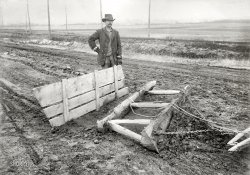
- Grub Rustler: 1939
- ... hat and the others would be worth a small fortune here in Colorado. And the hot sauce toothpick holder will be instituted here on our ... Posted by Dave - 06/04/2018 - 1:10pm -
![Grub Rustler: 1939 November 1939. "West Texan at eating house at auction. Stockyards, San Angelo, Texas." Photo by Russell Lee for the Farm Security Admin. View full size.
Two Happy Truckers!Absolutely enjoying lunch/dinner, and not worried a bit if Hitler will invade Poland or not!
$kinsThese two hard-working fellows would be amazed at what their "worn" jackets would bring on the vintage clothing market in just 79 years.
I Love My SandwichOh sandwich you are the greatest sandwich I have ever had. I wish I could marry you and keep you around always. I want you to last forever but with every mouthwatering bite you keep getting smaller.
I am in a quandary. To bite or not to bite? To just admire your beautiful lines and appealing aroma or to consume you with animal passion? Oh what to do? Oops there goes another bite and another and oh horrors you are gone. What am I to do?
I know. I'll ask the waitress for another.
Bing CrosbyIncognito.
DaaaaaaaaaaangThat ol' boy's been rode hard and put up wet.
No HopeJust Crosby.
RepurposingI like the use of sundae glasses to hold spoons and napkins. And the hot sauce bottle reused as a toothpick dispenser is a pretty neat idea.
Hard-working REAL cowboysThis reminds me of many days I have spent bringing visitors (who wanted to see real working cowboys) to visit the Okla. City Stockyards which I'm sure are similar to those everywhere. The workers who herd the cattle into the auction arenas must get very down and dirty and have to be exhausted after showing dozens of head of cattle on "auction day" and must ignore the, shall we say, sweet smell of success, particularly on hot summer days when the temp. is in the triple digits. These men work their butts off and it can't be easy. Our nearby cafe also has tables and a bar, but this old marble counter is a beauty and the display of depression glass utilitarian wares makes me nostalgic for days of yore.
Aches and Pains I noticed an aspirin tin over by his coffee and the hot sauce. Hard working guy probably full of aches and pains.
Cafe RorschachTook a minute to figure out that Royal Crown poster in the upper left was just a picture of knees.
OMGIt's a BLT!
EtiquetteWasn't it customary to remove your hat indoors?
[Not in places like this. - Dave]
Keeps you regular!The other two posters on the wall next to the "knees" are given away by their clock rounds denoting 10, 2 and 4.
Dr. Pepper's sales gimmick at the time was to prevent periodic midday slumps by obtaining a sugar blast at 10 am, 2 pm and 4 pm.
All HatThat hat and the others would be worth a small fortune here in Colorado. And the hot sauce toothpick holder will be instituted here on our table.
(The Gallery, Eateries & Bars, Russell Lee)](https://www.shorpy.com/files/images/SHORPY-8b23540a.thumbnail.jpg)
- C. City City Hall: 1942
- ... an old mining town in the mountainous region of Central Colorado." Acetate negative by John Vachon for the Farm Security ... Posted by Dave - 02/15/2022 - 11:54am -
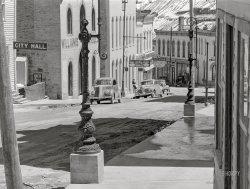
- Farm to Table: 1939
- October 1939. Greeley, Colorado. "Mrs. Milton Robinson, wife of Farm Security Administration borrower, ... Posted by Dave - 02/27/2017 - 10:44am -
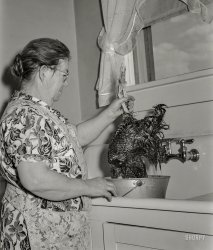
- No Horseplay: 1923
- ... slide at the hot springs pool in Glenwood Springs, Colorado. As a child in the 70's who could hardly swim, I made the regrettable ... Posted by Dave - 09/13/2011 - 12:01pm -
![No Horseplay: 1923 June 26, 1923. Back at the Wardman Park Hotel in Washington, D.C. Taken a year after the pool's opening in 1922, this photo shows the addition of a slide. National Photo Company Collection glass negative. View full size.
That slide is really steepI imagine coming down that slide would be quite a rush.
It really reminds me of the (long-gone) slide at the hot springs pool in Glenwood Springs, Colorado. As a child in the 70's who could hardly swim, I made the regrettable decision to try it out with the big kids and grownups. It shot me straight into the middle of the pool, in all of my arm-thrashing, snotty-nosed, "Daddy, help! Come save me!" glory. So embarrassing looking back on it now.
Stay FocusedRight hand side of the picture, almost half way up. Is that boy really wearing glasses while swimming?
Unfair!As a child in the 1940's I always wondered why girls were required to wear bathing caps in pools, while boys never were. And many of us had hair pretty much the same length. Sometime in the 60's (I think) bathing caps were no longer required.
SpecsThat kid on the right looks like he has his ordinary glasses on. Either that or swimming goggles were invented a lot earlier than I suspected.
Spectacular SwimmerI wear my glasses in the pool. And am fortunate to live in a time when swimsuits are no longer made of 100 percent wool.
TopsWell, good, I'm relieved to see we're on the topic of recreational aquatic attire, because I was wanting to ask what men's tops were supposed to be covering in this era. Why were they worn? And were the tops age-specific, like did the youngest boys go topless but older boys on up wore tops? Or was it more of a cultural thing — city males wore them, country males didn't? It just seems like an odd accessory given what I perceive as the acceptance of skinny-dipping in rural swimming holes in this general time frame.
(Sure, I could go to Google for answers to these questions, but I trust Shorpy readers more.)
[Men's tops were de rigueur at Washington's coed pools and bathing beaches in the 1920s. - Dave]
(The Gallery, D.C., Natl Photo, Sports, Swimming)](https://www.shorpy.com/files/images/09005u.thumbnail.jpg)
- Pike's Peak: 1901
- Colorado circa 1901. "Station and hotel, summit of Pike's Peak." 8x10 inch ... Posted by Dave - 08/15/2012 - 3:07pm -
![Pike's Peak: 1901 Colorado circa 1901. "Station and hotel, summit of Pike's Peak." 8x10 inch glass transparency, Detroit Publishing Company. View full size.
Isn't it amazingthat the Pikes Peak summit station and hotel were built only 110 years ago? That is so relatively recent in the exploration and history of the U.S. I like the three "Mary Poppins" dressed ladies who seem out of place in a rough and unfinished construction zone. I bet they're looking for the Ladies Room. This is a unique photo, very interesting.
Pikes Peak in colorAn example of the Photochrom prints that were made from these glass negatives. They were used for postcards and also for larger artwork that you might hang in your parlor. Click to enlarge.
+106Below is the same view from June of 2007.
Photo opCheck out the "other" photographer reclining and reading next to his camera/tripod setup.
SerendipityThis photo appeared on the same day I first found this site devoted to the PP Cog Railway on a family newsletter from folks who live nearby in CO. It has some videos and a pair of web cams.
Awesome!!!!Dave: this "stone-by-stone" colorized version is definitely one of the best I've seen on Shorpy. Some piece of work you did here. Thanks and congrats, pal!
[I didn't colorize it. As noted below, the image is a Photochrom print. - Dave]
(The Gallery, DPC, Railroads)](https://www.shorpy.com/files/images/4a29656a.thumbnail.jpg)
- Barrel of Monkeys
- ... front steps of the family home on Curtis Street in Denver, Colorado, 1980 by James Arroyo. These children are descendants from the original Hispanic settlers in Colorado and New Mexico. View full size.
Smiley! Look at all of ... Posted by SanLuis - 12/26/2011 - 8:29am -
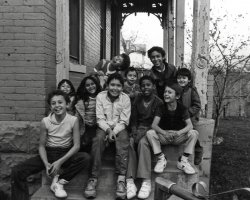
- Polaroid Portrait
- ... on the step of the family home on Curtis Street, Denver, Colorado. Mary Ann's family is originally from Antonito, Colorado and Truchas, New Mexico. View full size.
Correction That ... Posted by SanLuis - 01/22/2012 - 9:49pm -
![Polaroid Portrait Mary Ann Arroyo, 1978, taken by son James Arroyo on the step of the family home on Curtis Street, Denver, Colorado. Mary Ann's family is originally from Antonito, Colorado and Truchas, New Mexico. View full size.
CorrectionThat should be Truchas NM.
[Done. You can edit your submissions by clicking the "Edit" tab above the photo.]
(ShorpyBlog, Member Gallery)](https://www.shorpy.com/files/images/Mary_Ann_Arroyo_Poloroid.thumbnail.jpg)
- The Grill Room: 1912
- ... The Overlook When I look at this, all I can see is the Colorado Lounge.
Poached eggs, rarebit, and coffee The Edelweiss Cafe ... Posted by Dave - 08/08/2012 - 7:12pm -
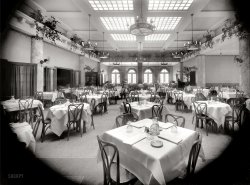
- Welcome to Denver: 1908
- ... for a view of the arch from the depot.
Denver, Colorado, circa 1908. "Welcome arch and Union Depot." Where blurry pedestrians ... Posted by Dave - 04/17/2014 - 9:35am -
![Welcome to Denver: 1908 Click here for a view of the arch from the depot.
Denver, Colorado, circa 1908. "Welcome arch and Union Depot." Where blurry pedestrians risk the retoucher's brush. 8x10 glass negative. View full size.
Because ...that's much less noticeable than a blurred pedestrian, right?
+104Below is the same view from July of 2012.
SuperheroI think that might be the Human Torch crossing the street there.
My kind of place !The Oxford Hotel looks like my kind of place. Cigars on one side, bar and restaurant on the other and a nice group of chairs in the middle! Time to sit down and have a smoke!
Photo RetouchingBy the time this photo was taken in 1908, the airbrush had been around for nearly a decade. It's level of sophistication and ease of operation may not have been quite on par with modern machines, but would have definitely done a better retouching job on the blurred pedestrian than this feeble attempt done by a regular brush. From someone who did his share of photo retouching the old school way with an airbrush, retouch grays, and frisket paper, let me tell you that I love PhotoShop immensely.
[The actual "retouching" would be done while preparing the lithograph printing stones, in effect repainting the area. My guess is that the scratching out of the pedestrian was a method of calling attention to the necessity of doing so. -tterrace]
Right you are! My remarks would only pertain to photographic print retouching. Thanks!
Modern advertising skillsThe Depot Drug Store's slogan, painted on the side of the building, is "Come In and Wait". I'm not sure that kind of slogan would work today.
Welcome ArchShortly after this photo was taken, this side of the arch was changed to "Mizpah" - Hebrew for "God watch over you while we are apart" - after some citizens pointed out that "Welcome" didn't make sense for people passing under as they departed. "Welcome" remained on the arrival side until the arch was declared a traffic hazard and removed in 1931. The central portion of the depot lost its tower when it was rebuilt in Romanesque style in 1914
WhenWas the Arch installed and by whom?
(The Gallery, DPC, Railroads, Stores & Markets, Streetcars)](https://www.shorpy.com/files/images/SHORPY_4a23004a.thumbnail.jpg)
- Paonia High School: 1926
- The 1926 Paonia, Colorado high school girls basketball team. My grandmother is 4th from the ... who was the only junior that season. They were the western Colorado girls champions that year. Grandma died just last year (2010) at the ... Posted by fred58 - 09/14/2011 - 10:46am -

- Cafe Ginza: 1941
- ... years of internees at the Granada relocation center in Colorado.
Poster on the Left The poster on the left is for "Niji tatsu ... Posted by Dave - 12/07/2012 - 3:19pm -
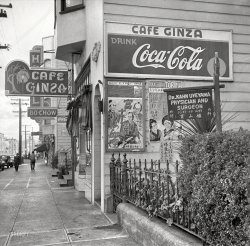
- Woodman Home: 1919
- ... were sanatoriums (tuberculosis hospitals). Woodman Home in Colorado Springs, Colorado was one of those. She does not say who the four women posed in the ... Posted by aenthal - 07/01/2016 - 8:58pm -

- Human Roulette: 1908
- ...
I puked Probably 1941 at an amusement park in Denver Colorado, I got in the center and was the last one off.
No Human Pool ... Posted by Dave - 06/25/2014 - 8:16pm -
